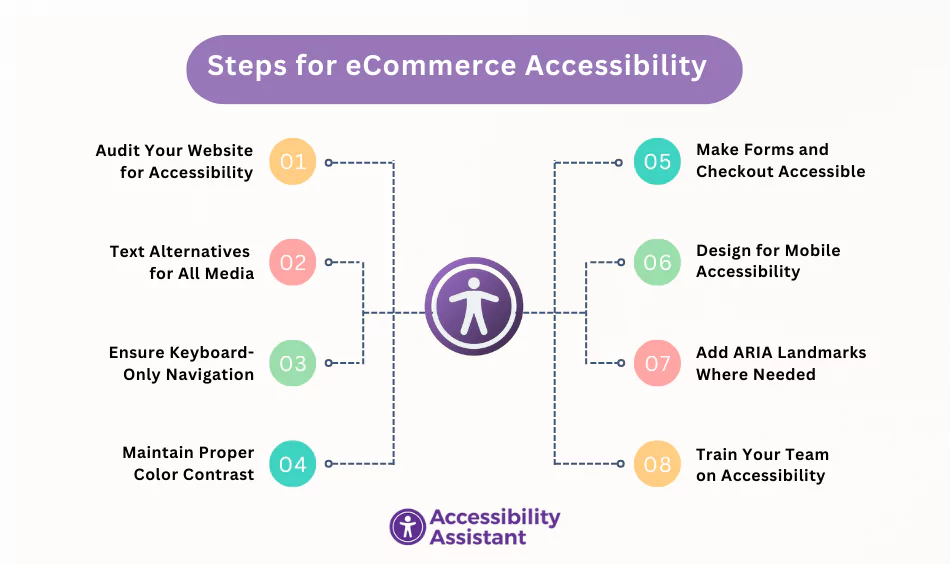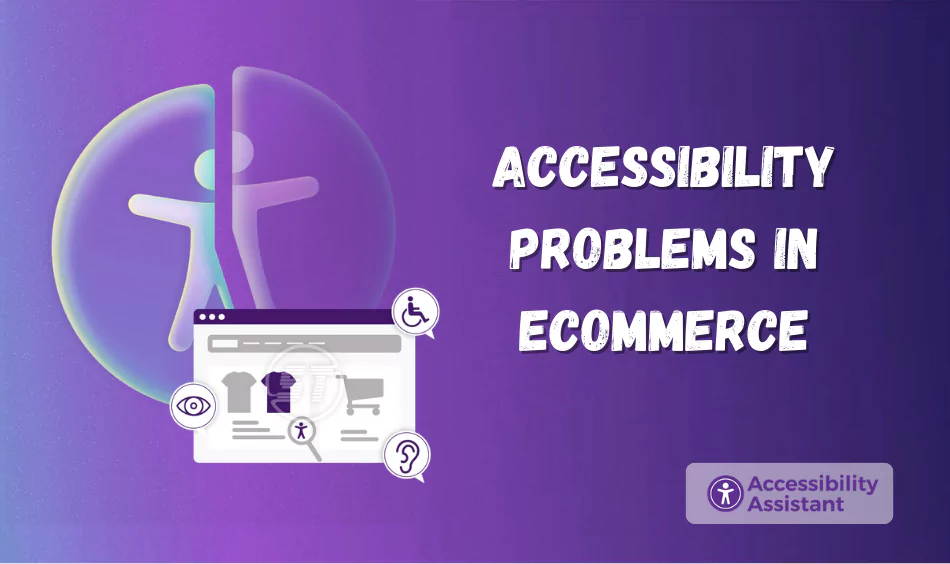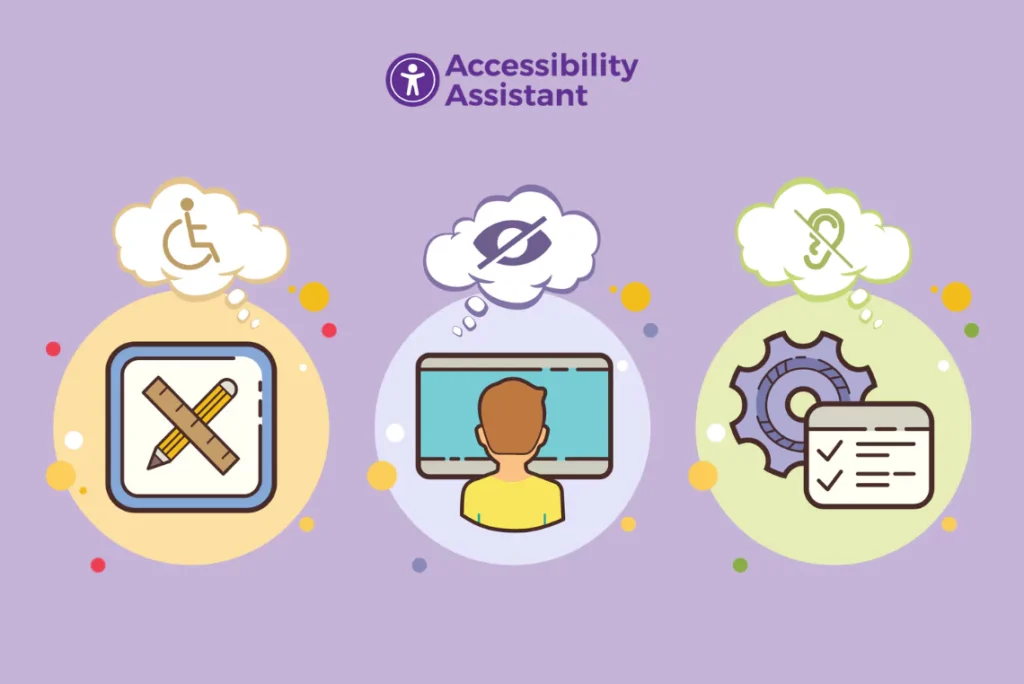Introduction
In today’s competitive online retail space, E-Commerce accessibility is no longer non-obligatory; it’s an enterprise requirement. Millions of users with disabilities engage with online stores daily, and in case your website isn’t available, you’re excluding a big part of potential clients.
Beyond inclusivity, ADA compliance for e-commerce is a legal requirement within the U.S. The Americans with Disabilities Act (ADA) mandates that virtual structures, together with online shops, provide the same access to individuals with disabilities. Meeting WCAG (Web Content Accessibility Guidelines) guarantees your shop is both legally compliant and person-pleasant.
In this guide, you’ll learn:
- What eCommerce website accessibility means and why it matters.
- Key ADA compliance steps for online stores.
- Common accessibility barriers in e-commerce and how to fix them.
- Real-world examples of brands succeeding with accessibility.
- Tools and resources to maintain ongoing compliance.
Why E-Commerce Accessibility Drives Business Growth and Ensures Compliance
Accessibility in eCommerce isn’t merely about compliance; it’s a strategic lever for unlocking growth, building trust, and enhancing SEO performance in today’s digital landscape.
- Surging Legal Risk
From January to June 2025, U.S. courts recorded 2,014 ADA website accessibility lawsuits, marking a 37% increase compared to the same period in 2024. By year-end, lawsuits are projected to exceed 4,975 cases, with e-commerce sites being particularly targeted. - Improved SEO & Usability
Accessible websites feature better site structure and code, which search engines reward. As observed following Google’s December 2022 Helpful Content update, user-first experiences, like those delivered through accessible design, are increasingly prioritized in rankings. - Higher Conversions & Better UX
Inaccessible sites create real obstacles. A study revealed that 37% of shoppers abandon eCommerce sites due to poor navigation or limited payment options, and 42% decide whether to stay or leave within just 10 seconds. Accessibility directly mitigates these barriers. - Market Expansion & Inclusion
Around 1 in 4 U.S. adults lives with a disability. Accessible online experiences not only serve this underserved group but also enhance overall user satisfaction—boosting loyalty and repeat purchases
ADA Compliance Essentials for eCommerce Websites
The following checklist highlights the core regions of ADA compliance every e-commerce enterprise needs to address. In 2025, with stricter WCAG 2.2 standards and elevated felony scrutiny, these steps are more critical than ever for ensuring your online presence is offered, inclusive, and risk-free.
| Area | ADA Compliance Action | Benefit | Latest Update |
| Images & Media | Add descriptive alt text, captions, and transcripts | Supports visually and hearing-impaired users | Include ARIA labels for interactive images to improve screen reader interpretation |
| Navigation | Ensure keyboard accessibility and logical tab order | Helps users with motor disabilities | Provide visible focus indicators that meet WCAG 2.2 focus appearance standards |
| Color & Contrast | Maintain WCAG contrast ratio of at least 4.5:1 | Improves readability for the visually impaired | Test against WCAG 2.2 guidelines to address additional contrast needs for active elements |
| Forms & Checkout | Use clear labels and error messages | Ensures a smooth purchase process | Implement real-time error validation for better accessibility and usability |
| Mobile Accessibility | Use responsive design and mobile-friendly navigation | Covers all device users | Follow WCAG 2.2 mobile touch target size guidelines for better tap accuracy |
| Testing & Auditing | Run automated and manual accessibility tests regularly | Keeps store compliant over time | Perform quarterly audits and include user testing with assistive technologies |
Steps to Achieve ADA Compliance for eCommerce Accessibility

1. Audit Your Website for Accessibility
- Use tools like:
- Check for WCAG 2.2 violations such as missing alt text, insufficient color contrast, inaccessible navigation, and untagged forms.
- Combine automated testing with manual reviews, including real user testing with assistive technologies.
- Pro Tip: Ensure your audit includes focus appearance requirements and drag-and-drop accessibility, as they’re new WCAG 2.2 success criteria.
2. Provide Text Alternatives for All Media
- Add alt text for all product images, promotional banners, and icons.
- Include captions for videos and transcripts for audio so content is accessible to users with hearing impairments.
- For decorative images, leave the alt attribute empty (alt=””) so screen readers skip them.
- Pro Tip: Use AI-powered tools to generate draft alt text, but always review for accuracy and context.
3. Ensure Keyboard-Only Navigation
- Menus, product filters, and checkout steps must be fully navigable via keyboard.
- Maintain logical tab order to improve usability.
- Add visible focus indicators that meet WCAG 2.2 focus appearance standards.
4. Maintain Proper Color Contrast
- Follow WCAG guidelines: minimum contrast ratio of 4.5:1 for normal text and 3:1 for large text.
- Avoid using color alone to convey meaning (e.g., marking required fields only in red).
- Pro Tip: Test color contrast for hover and focus states—a common area of non-compliance in audits.
5. Make Forms and Checkout Accessible
- Label all input fields clearly and link labels programmatically to form controls.
- Provide text-based error messages, not just visual cues like color changes.
- Ensure payment and checkout processes work seamlessly with screen readers and keyboard navigation.
- Pro Tip: Add autocomplete attributes to speed up form filling for all users, including those using assistive tech.
6. Design for Mobile Accessibility
- Use responsive layouts that adapt to any screen size.
- Ensure tap targets meet WCAG 2.2 minimum size requirements (at least 24x24px).
- Test accessibility features on iOS and Android devices using built-in screen readers like VoiceOver and TalkBack.
7. Add ARIA Landmarks Where Needed
- Use ARIA (Accessible Rich Internet Applications) attributes to help assistive technologies interpret your page layout.
- Examples: <nav role=”navigation”>, <main role=”main”>, <footer role=”contentinfo”>.
- Avoid overuse—ARIA should complement, not replace, semantic HTML.
8. Train Your Team on Accessibility
- Provide training on ADA and WCAG compliance for content creators, designers, and developers.
- Create internal accessibility documentation so updates don’t break compliance.
- Pro Tip: Incorporate accessibility checks into your CI/CD pipeline so every update is tested before deployment.
Common Accessibility Barriers in eCommerce Websites (and How to Fix Them)
Even in 2025, many online stores still forget about simple accessibility requirements, leading to poor person reviews and legal risks. According to the latest accessibility audits, over 96% of e-commerce homepages include at least one WCAG failure, maximum of them avoidable with proper planning.

Here are some of the most frequent accessibility issues in e-commerce:
- Missing or Incorrect Alt Text on Product Images
- Without accurate alt text, screen readers can’t describe products to visually impaired users.
- Pro Tip: Ensure every product image has descriptive, keyword-relevant alt text and that decorative images have empty alt=”” attributes.
- Navigation Menus That Don’t Work with Keyboards
- Many dropdown menus are inaccessible without a mouse.
- Pro Tip: Use semantic HTML and ARIA roles to ensure menus are keyboard-friendly with logical tab order and visible focus states.
- Low-Contrast Text on Promotional Banners
- Text that doesn’t meet the WCAG 2.2 minimum contrast ratio (4.5:1 for normal text) is difficult to read.
- Pro Tip: Test banners in both desktop and mobile formats, and adjust contrast for hover/focus states too.
- Videos Without Captions or Transcripts
- This excludes users who are deaf or hard of hearing.
- Pro Tip: Always provide synchronized captions and downloadable transcripts for promotional and instructional videos.
- Checkout Forms Without Proper Labels
- Unlabeled form fields create significant barriers for screen reader users.
- Pro Tip: Programmatically link <label> elements to form inputs and provide text-based error messages.
By addressing those limitations, eCommerce businesses now not only meet ADA and WCAG 2.2 requirements but also improve usability for all clients, leading to better conversions and reduced cart abandonment.
Good Read:- After understanding the steps to achieve compliance, see the Top 10 E-Commerce Accessibility Mistakes (and How to Fix Them) to ensure you’re not overlooking critical issues.
Real-Life eCommerce Accessibility Success Story
In 2024, a U.S.-primarily based clothing retailer acquired an ADA-associated compliant after a visually impaired customer struggled to finish a purchase. The website’s checkout fields were unlabeled, and promotional banners had poor colour contrast, making it difficult for users and people with low vision and prescient to navigate.
Facing potential legal action and negative brand perception, the retailer implemented the Accessibility Assistant solution across its stores:
- Accessibility score jumped from 66% to 98% within 72 hours.
- Cart abandonment decreased by 14%, thanks to smoother navigation and a more accessible checkout flow.
- Customer satisfaction ratings improved, with shoppers specifically praising improved focus indicators, descriptive product alt text, and better mobile usability.
- The site achieved full WCAG 2.2 compliance for all critical shopping flows, reducing the risk of future ADA lawsuits.
- The retailer’s organic search traffic grew by 11% in three months, attributed to better site structure and accessibility-driven SEO improvements.
Key takeaway: Accessibility isn’t just a compliance checkbox; it directly impacts sales, customer loyalty, and SEO performance.
Pros & Cons of Achieving eCommerce Accessibility
While e-commerce accessibility offers measurable advantages, it additionally requires commitment and resources. In 2025, with WCAG 2.2 updates and increasing ADA enforcement, the stability between attempt and reward is more essential than ever for online store owners.
Pros
- Expands Customer Base
An accessible site welcomes the 61 million U.S. adults living with disabilities, plus millions more worldwide. Inclusivity increases your potential audience and opens doors to underserved markets. - Improves SEO Rankings
Accessible websites tend to have cleaner code, better heading structures, and faster load times—all of which align with Google’s Core Web Vitals and ranking factors. - Reduces Legal Risks
In the first half of 2025, over 2,000 ADA lawsuits were filed against websites, with e-commerce making up nearly 70% of them. Compliance significantly lowers the chance of costly litigation. - Strengthens Brand Trust
A reputation for inclusivity can increase customer loyalty and advocacy. Consumers increasingly prefer brands that actively support accessibility and diversity.
Cons
- Initial Investment in Accessibility Improvements
Implementing accessibility updates—especially on large, complex eCommerce sites—may require design changes, development work, and content updates. - Requires Continuous Monitoring After Updates
Every new product page, design refresh, or app integration can introduce accessibility issues. This means regular testing is essential, ideally using a tool like Accessibility Assistant for automated monitoring and alerts.
FAQs About E-commerce accessibility
Q1: What is accessibility in e-commerce?
Accessibility in eCommerce means designing and developing your online store so that people with disabilities can easily navigate, understand, and complete transactions. This includes following ADA and WCAG guidelines for elements like images, navigation, forms, and mobile responsiveness.
Q2: Is ADA compliance required for e-commerce stores?
Yes. If you operate in the U.S. or sell to U.S. customers, your store must comply with the Americans with Disabilities Act and meet WCAG standards. Non-compliance can lead to lawsuits, fines, and loss of customer trust.
Q3: How often should I check eCommerce accessibility?
You should perform accessibility audits quarterly and after every significant update or theme change. Many 2025 lawsuits target businesses that were previously compliant but did not maintain accessibility over time.
Q4: Does accessibility cover mobile devices?
Yes. ADA and WCAG compliance apply to mobile websites and apps as well as desktop versions. WCAG 2.2 adds new rules for touch target sizes and focus indicators, making mobile accessibility a priority.
Q5: What’s the fastest way to achieve compliance?
Using Accessibility Assistant is one of the quickest and most cost-effective ways to fix accessibility issues. It provides real-time monitoring to ensure your store remains compliant after updates.
Conclusion
eCommerce accessibility is essential for legal compliance, user experience, and business growth. By following ADA and WCAG guidelines, you ensure your online store is inclusive, search-friendly, and conversion-ready.
Start your compliance journey today with Accessibility Assistant Pricing Plans and make your eCommerce store accessible today.

